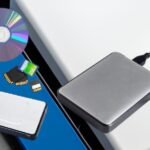Flash memory has revolutionized the landscape of digital storage, becoming a ubiquitous technology in various electronic devices and systems. This comprehensive exploration delves into the intricacies of flash memory, unraveling its fundamental principles, key components, recent innovations, notable applications, and the transformative impact it has on reshaping the way we store, access, and manage data in the digital age.
Understanding Flash Memory
Flash memory is a non-volatile semiconductor memory that retains data even when power is turned off. Unlike traditional volatile memory, such as RAM, it does not require continuous power to maintain stored data, making it ideal for long-term storage in electronic devices.
Key Components of Flash Memory
The core components of flash memory contribute to its functionality and effectiveness in various applications:
- Memory Cells: Each memory cell stores some data as an electrical charge, typically represented as 0 or 1. These cells are organized into arrays, each containing multiple cells arranged in rows and columns.
- Floating Gate Transistors: The key building block of flash memory cells, floating gate transistors trap or release electrical charge to represent data states (0 or 1) without needing continuous power.
- Control Gates: Control gates regulate the flow of electrical charge to and from the floating gate transistors, enabling data programming (writing) and reading operations in the flash memory.
Types of Flash Memory
Flash memory comes in several forms, each suited for different applications and use cases:
NAND Flash Memory
NAND flash memory is the most common type of flash memory used in mass storage devices, such as USB drives, SSDs (Solid-State Drives), and memory cards. It offers high storage capacity and fast read/write speeds, making it ideal for data-intensive applications.
NOR Flash Memory
NOR flash memory is typically used in low-density, high-performance applications, such as firmware storage in embedded systems and microcontrollers. It offers fast random access and execute-in-place (XIP) capabilities, enabling direct code execution from the memory.
Recent Innovations in Flash Memory
Recent innovations have propelled flash memory technology to new heights, enabling higher capacities, faster speeds, and improved reliability. Notable advancements include adopting 3D NAND technology, developing multi-level cell (MLC) and triple-level cell (TLC) architectures, and the integration of error correction algorithms.
3D NAND Technology
3D NAND technology stacks memory cells vertically to increase storage density and reduce manufacturing costs, enabling higher capacities and improved performance in flash memory devices while maintaining compact form factors.
Multi-Level Cell (MLC) and Triple-Level Cell (TLC) Architectures
MLC and TLC architectures enable each memory cell to store multiple bits of data, increasing storage density and reducing cost per bit. These architectures balance capacity, performance, and reliability to meet the demands of diverse storage applications.
Notable Applications of Flash Memory
Flash memory has diverse applications across various industries and domains. It powers various electronic devices and systems, from smartphones and tablets to data centers and automotive infotainment systems.
Consumer Electronics
It provides fast and reliable storage for apps, photos, videos, and other digital content in consumer electronics, such as smartphones, tablets, and digital cameras, enabling seamless user experiences and multimedia playback.
Data Storage and Enterprise Applications
In data centers and enterprise environments, it-based SSDs offer high-speed storage solutions for mission-critical applications, such as database servers, virtualization, and cloud computing, improving data access and processing performance.
Challenges in Flash Memory
Despite significant advancements, flash memory technology faces challenges that impact its performance, reliability, and scalability in demanding applications. Addressing these challenges is crucial for ensuring its continued evolution and adoption.
Endurance and Wear
Ensuring endurance and wear leveling in flash memory devices poses challenges due to limited write/erase cycles. To extend the lifespan of the memory cells and maintain data integrity, advanced wear-leveling algorithms and error correction techniques are necessary.
Cost and Scalability
Balancing cost and scalability in flash memory manufacturing poses challenges due to the complexity of 3D NAND fabrication processes and the need for continuous innovation to increase storage densities and reduce manufacturing costs per bit.
Future Trends in Flash Memory
The trajectory of flash memory technology indicates exciting trends that will further redefine its capabilities and applications in the digital transformation era. These trends promise to enhance capacity, performance, and reliability, ushering in a new era of flash memory innovation and connectivity.
QLC (Quad-Level Cell) and PLC (Penta-Level Cell) Architectures
The development of QLC and PLC architectures enables each memory cell to store even more bits of data, further increasing storage densities and reducing cost per bit, opening up new possibilities for high-capacity storage solutions in consumer and enterprise applications.
Emerging Memory Technologies
The emergence of emerging memory technologies, such as Resistive RAM (RRAM), Phase-Change Memory (PCM), and Spin-Transfer Torque RAM (STT-RAM), offers potential alternatives to flash memory, providing higher performance, lower power consumption, and improved endurance in next-generation storage solutions.
Conclusion
Flash memory is a foundational technology in the digital storage ecosystem, enabling efficient, reliable, and high-speed storage solutions for various applications and use cases. From consumer electronics to data centers and automotive systems, the impact of flash memory extends across diverse industries and domains, reshaping the way we store, access, and manage data in the digital age. Despite challenges, ongoing innovations in 3D NAND technology, multi-level cell architectures, and emerging memory technologies promise a future where flash memory continues to push the boundaries of what is possible, unlocking new opportunities for efficiency, scalability, and innovation in digital storage solutions.










